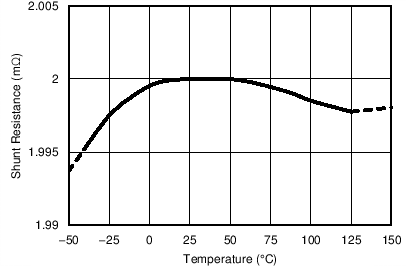ZHCSDO5C April 2015 – September 2023
PRODUCTION DATA
- 1
- 1 特性
- 2 应用
- 3 说明
- 4 Revision History
- 5 Pin Configuration and Functions
- 6 Specifications
- 7 Detailed Description
- 8 Applications and Implementation
- 9 Device and Documentation Support
- 10Mechanical, Packaging, and Orderable Information
7.3.3 Temperature Stability
System calibration is common for many industrial applications to eliminate initial component and system-level errors that can be present. A system-level calibration can reduce the initial accuracy requirement for many of the individual components because the errors associated with these components are effectively eliminated through the calibration procedure. Performing this calibration can enable precision measurements at the temperature in which the system is calibrated, but as the system temperature changes as a result of external ambient changes or due to self heating, measurement errors are reintroduced. Without accurate temperature compensation used in addition to the initial adjustment, the calibration procedure is not effective in accounting for these temperature-induced changes. One of the primary benefits of the very low temperature coefficient of the INA250 (including both the integrated current-sensing resistor and current-sensing amplifier) is ensuring that the device measurement remains highly accurate, even when the temperature changes throughout the specified temperature range of the device.
For the integrated current-sensing resistor, the drift performance is shown in Figure 7-3. Although several temperature ranges are specified in the Electrical Characteristics table, applications operating in ranges other than those described can use Figure 7-3 to determine how much variance in the shunt resistor value can be expected. As with any resistive element, the tolerance of the component varies when exposed to different temperature conditions. For the current-sensing resistor integrated in the INA250, the resistor does vary slightly more when operated in temperatures ranging from –40°C to 0°C than when operated from 0°C to 125°C. However, even in the –40°C to 0°C temperature range, the drift is still quite low at 25 ppm/°C.
 Figure 7-3 Sensing Resistor vs Temperature
Figure 7-3 Sensing Resistor vs TemperatureAn additional aspect to consider is that when current flows through the current-sensing resistor, power is dissipated across this component. This dissipated power results in an increase in the internal temperature of the package, including the integrated sensing resistor. This resistor self-heating effect results in an increase of the resistor temperature helping to move the component out of the colder, wider drift temperature region.